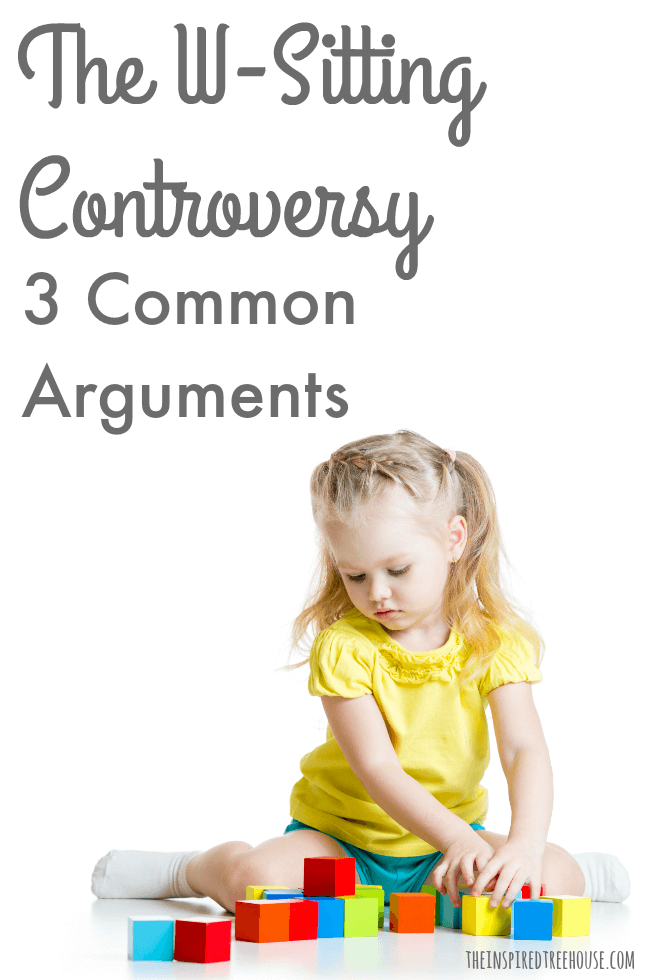The W-Sitting controversy has sparked some strong opinions and comments here at The Inspired Treehouse. Today, we wanted to answer to 3 of the most common comments we see about this topic.
The W-Sitting Controversy
Several months ago, we wrote one of our very first Tricks of the Trade posts about W-sitting, and WOW, we were shocked by the outpouring of response and interest!
There were over 100 comments on our post from readers with many varying opinions. And while we didn’t expect the W-sitting controversy to explode all around us, we are really glad that it sparked some conversation about the topic.
Below, we will address some of the most common questions and concerns our W-Sitting post has raised. You can also read more about the W-sitting debate here.
Comment #1
My child sat like this and never had any of the problems you described in your post about W-Sitting. -or-
I sat like this all my life and I’ve never had any problems because of it.
Our Response
To us, this is similar to saying, I never wear my seatbelt and I’ve never been in an auto accident. It is not our stance that every child is going to suffer consequences from w-sitting. Instead, our post was written to inform readers about the possible implications of w-sitting from a physical therapist’s perspective based years of clinical practice and observation.
Our concerns are valid. A child cannot fully rotate his trunk to reach when his bottom is planted on the floor between his legs. This restricted movement can negatively impact the acquisition of developmental milestones.
In W-sitting, kids are placing their hips in a position that is compromising the integrity of the joint which, in times of rapid bone growth, could affect how the femur and tibia bones grow and form. Young bones and joints are affected by the habitual patterns in which they are positioned.
The statement: “I have never had a problem” may also be misleading. You may have pain or discomfort through your hips, feet, back, neck, etc. that are related to your history of w-sitting, but you may never have attributed it to this cause.
We don’t like to get technical at The Inspired Treehouse. Our blog is about breaking information about child development down into easy to understand language. However, we are licensed, practicing physical and occupational therapists, meaning that we do have the clinical background and medical knowledge to back our professional opinions. If you would like to read more about the specifics of developmental biomechanics, here is a great article.
We have received hundreds and hundreds of comments on the post and on our social media sites about this topic. For every one person saying that they’ve had a problem related to W-Sitting, there is another person who says that they have never experienced any consequences from sitting this way. This being the case, we would expect that our readers would want to have that knowledge in order to offer their children and the children in their care alternative options for ways to sit and play.
Comment #2
“This is helicopter parenting at its finest. Let kids be kids and sit how they want to sit.”
Our Response
We bet you have made many choices since your child was born: not to sleep him on his tummy when he was a baby to keep him safe, not to let him watch too much tv, making sure he eats all of his veggies, requiring that he wears a helmet when he rides his bike. Parenting is about making decisions based on the best information you have. You decide whether the consequences of a particular action or behavior are significant enough to address it on a regular basis.
Correcting W-Sitting with your child doesn’t have to require constant hovering, nagging, or any negative interaction at all. Keep it playful!
Simply asking your child to get up and retrieve a favorite toy may be enough to change up his positioning the next time he sits back down. Use a “secret” code word to cue your child to change position, give him alternate places and ways to sit such as: a beanbag chair, a pillow to sit on, or even suggest that he lay on his tummy and get down there next to him in the same position. Pretty soon, these will become his new positions and habits.
Be sure to look back at our original post on W-Sitting to see our video of 5-year-old Finn demonstrating suggestions for alternatives to W-Sitting.

Comment #3
What if my child has a specific diagnosis that makes W-Sitting most comfortable for him/her?
Our Response
W-Sitting is not a natural developmental sitting position. If your child is a habitual W-Sitter, meaning that they sit this way all the time and are unable to get into any other comfortable position on the floor, we recommend that you approach the topic with your pediatrician. It may be determined that there is an underlying orthopedic reason that your child is a W-Sitter. If there is not an orthopedic concern, your child’s W-Sitting may be attributed to another underlying cause, such as the need for core strengthening.
We hope we’ve been able to address some of the main areas of concern raised by our post about W-Sitting. We look forward to hearing more from you on this topic.
What do you think? What has your experience been with W-Sitting? If you are a therapist, how do you discuss topics like W-Sitting and Toe Walking with your clients? We’d love to hear in the comments below.
Are you a therapist, teacher, or caregiver working with kids who are W-Sitters? Click here to find our free printable W-Sitting Handout to share with others!



Latest posts by Lauren Drobnjak (see all)
- End of the Year Gifts for Therapists - April 14, 2024
- Playful Therapy Posters to Spruce Up Your Room - March 30, 2024
- How to Help a Baby Crawl & Creative Crawling Patterns We See in Therapy - March 19, 2024



[…] am constantly saying “fix your legs” or “NO “W” SITTING!”. What’s so wrong with W-sitting? Let’s […]